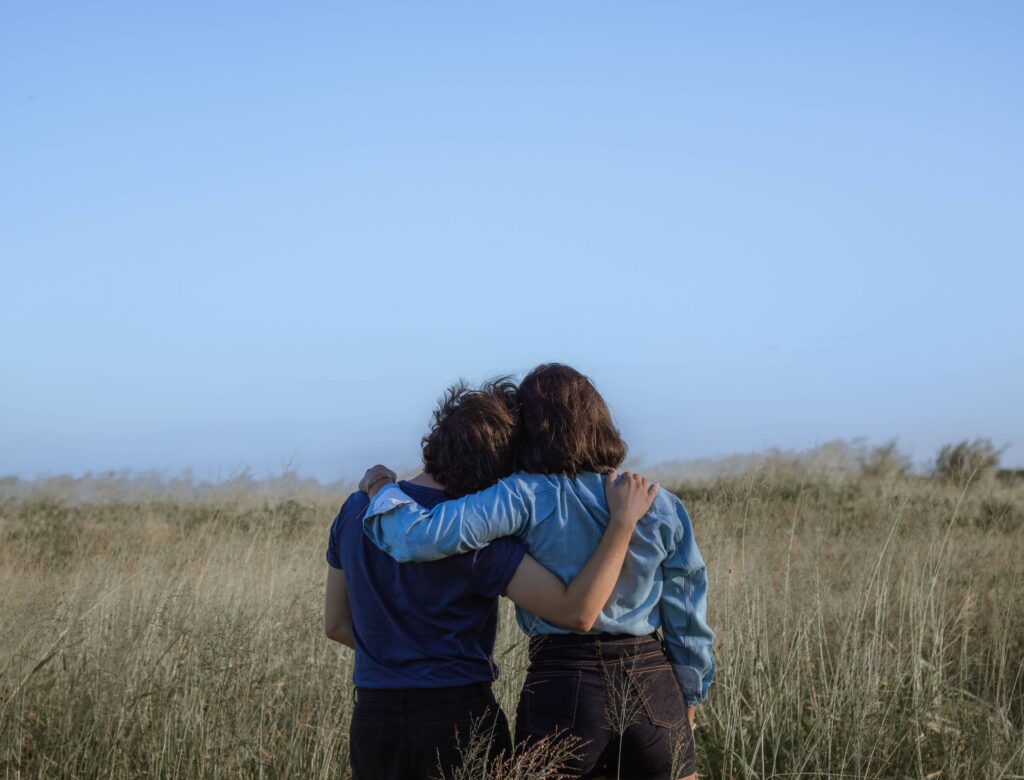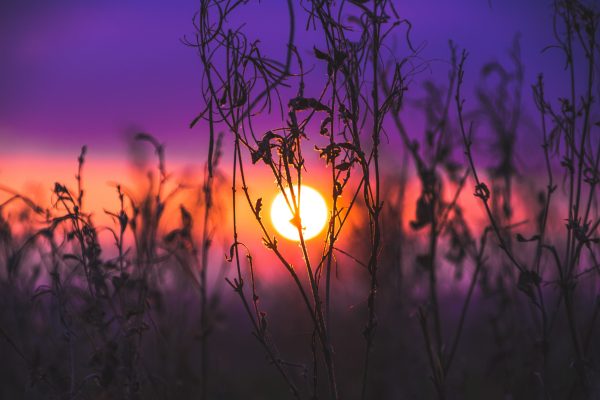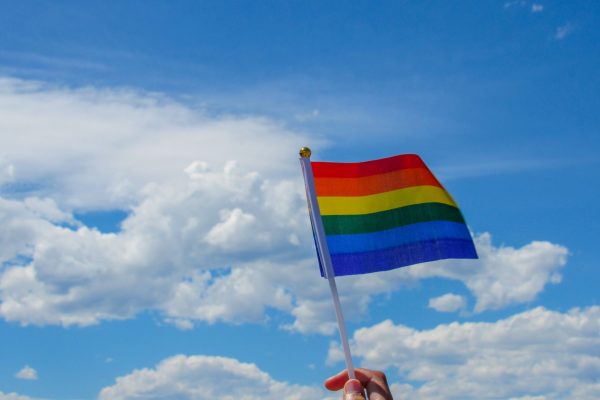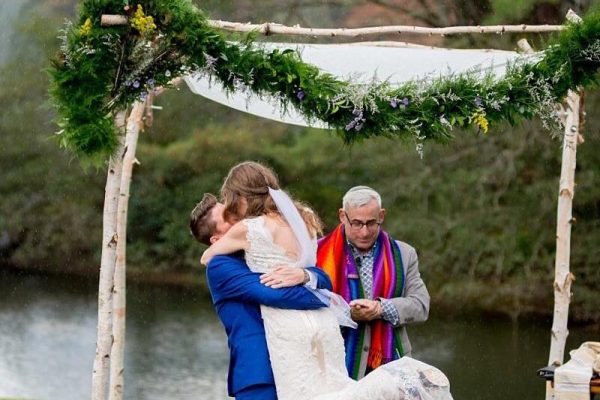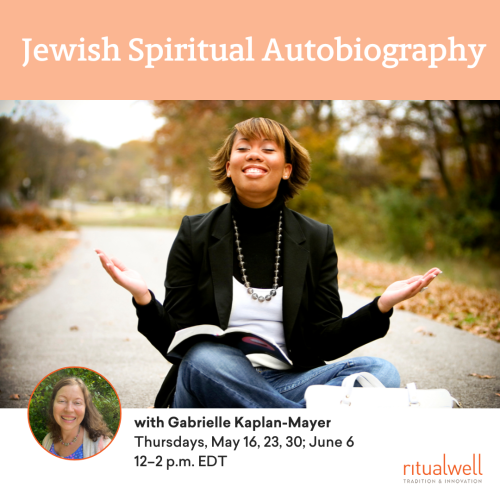ROSANNE and JUDY
Rosanne Leipzig, a 41-year-old physician, and Judy Mable, a 45-year-old vascular clinician, were partners for two years before publicly consecrating their relationship under a wedding huppahMarriage canopy symbolizing the couple's new home.. What follows is an account not of their actual ceremony, but of the preparation for the wedding—a journey that surprisingly sowed much healing, joy, and empathy all around.
JUDY:
Initially we had no concept of what type of ceremony to have. We were both very involved in the gay synagogue, and the more we talked, the clearer it became that we wanted a Jewish ceremony. So we bought a book called The New Jewish Wedding. Every night we read a chapter together. I had never thought it would ever he possible for me to have, for lack of a better word, a wedding. So for me, even thinking about being able to have such a ceremony was exciting.
ROSANNE:
One important aspect of preparing for it was that the process really emboldened us to come out. For me, it started when we sat down to put together a guest list. I kept feeling that had I done this as a heterosexual wedding several years before, when my parents were alive, there were many relatives that I would have invited. When I sat down to make this guest list. I realized that because I was gay I had really distanced myself from many members of my family. I have a very large extended family, and I had no idea how they felt about me or how they would feel about this ceremony. I had always just gone under the assumption that since my mother had had difficulty with my being gay. the rest of the family would too. But when we started to figure out whom to invite, I said, “I have no reality check on this at all. Let’s just see.”
What we did was to send out a postcard to everyone we wanted to invite early on, before the details were set, just letting them know to save the date. And then, to the family members to whom I wasn’t out, I sent a cover letter that said:
Judy and I have decided to share our lives together and will be having a BritLit. Covenant. Judaism is defined by the covenant - the contract between the Jewish people and God. God promises to make us abundant and to give us the land of Israel; we promise to obey God's commandments. This covenant begins with Abraham and is reiterated throughout the Torah. A brit milah, literally a covenant of circumcision, is often simply called a brit or bris. Ahavah [the Hebrew term we coined for this, meaning, literally, a covenant of love].
I’m sorry I haven’t spoken directly with you about this before. Over the years my fears of rejection have kept me from being open and close with many people who mean a great deal to me. Now, to my delight, my own growth and my relationship with Judy have helped me arrive at a comfortable place where I can share this important step with the people I care about the most.
I hope you will be able to share our simcha [happy event] with us, but if not, I hope we stay more closely in touch.
We sent this out to about sixty people, and we presumed that out of that we would hear from twenty, and three would come. Well, were we surprised. We got back the most beautiful letters from almost everyone we’d written. Thirty of these people ended up coming, all from out of town, including seventy-year-old cousins and aunts.
JUDY:
Rosanne’s family also sent wonderful material for the huppah, which is the canopy under which Jewish weddings are held. We had decided to make our own huppah so on the postcard we requested fabric from all of our friends and family members; we asked for any piece of fabric that was significant to them. Then, after the mailman had lugged up seventy or eighty packages of material for us, we sewed it all together. It contained everything from babies’ blankets to wedding dresses to pieces of fabric designed especially for the huppah.
ROSANNE:
Much of what we got back from members of my family were items that had belonged to my late parents or to my grandparents. It was really very moving.
JUDY:
I have a much smaller family than Rosanne. My father is alive; my mother is dead. I have a sister, a niece and a nephew. My sister has been married twice, and both her current husband and her ex-husband came, which was interesting! My family had not been together since my mom died thirteen years ago, so this was very special.
The most amazing thing for me was having my father there. He had been a career Navy officer for thirty years and had always been a rigid man. When he learned I was gay, he was not too pleased, to say the least. For him to witness this event was extraordinary. He spent a good part of the time reflecting on how he behaved when I was growing up. He began to realize what a tyrant he had been. He also cried, wishing my mother could have been there. Most extraordinary for me, though, was the fact that he was there, and that he has accepted Rosanne and been supportive of the relationship. I think he has grown with us, and, at sixty-eight, he’s changed. It felt like a miracle to have him share that day with me.
ROSANNE:
The other part of the huppah story is bittersweet. When we first told our friends, Shelly and Jay, that we wanted this ceremony, Shelly looked at us skeptically and said, “What do You want to do something like that for?” He started saying the old stuff about aping heterosexual tradition, and so on. Then, as the four of us sat and talked about it, he got more and more enthused about the idea. We talked about how much we wanted to celebrate our love with the people we cared about. Finally we got to the part about wanting to make the huppah, and he said he wanted to embroider the center piece for us using our Hebrew names.
It turned out that while he was still working on it he was hospitalized with AIDS. He worked feverishly and finally finished it. It has our Hebrew names, and then on the bottom it says, “With love from Shelly and Jay.” The day after he finished embroidering it, he lost the use of his right hand. He regained use for a short time and signed our ketubahThe Jewish wedding contract. Traditionally, the ketubah protected the wife in marriage by spelling out the husband's obligations to her and guaranteeing her a financial settlement in case of divorce. Throughout the ages, ketubot (plural) have been illuminated and calligraphed, becoming significant as Jewish art. Today, all manner of egalitarian ketubot are written. Some dispense with the financial and legal aspects, focusing more on the emotional and spiritual sides of the relationship. Others maintain the rabbis' concern with the practical, but define mutual obligations for each spouse., which is the document stating the contract of the wedding. He died a few months later.
We used many of the traditional symbols from a Jewish wedding, sometimes modifying them for our purposes. We commissioned an artist to make our ketubah [a wedding contract, often wrought as a beautiful piece of art].
JUDY:
We went to a Hebrew arts fair, where we met this ketubah-maker. We decided to ask her if she would custom-make a ketubah for us. Twenty minutes later, we were still pacing around, passing her again and again: ‘Should we? Shouldn’t we’? No, yes.”
ROSANNE:
Finally we went up to her, and I said, ”I think you’ve probably never been asked this question before, but would you do a ketubah for two women!” About two seconds passed, and she looked at us and said, ”Is it a Jewish ceremony?” We said, ‘Yes!” She was initially reluctant to use the term ketubah because she said that to her that term was specific to a heterosexual ceremony. That made us uncomfortable, and for a while we weren’t sure we wanted her to do it, as we didn’t want to work with someone who wasn’t completely supportive. Then we went to her studio to reopen the discussion. You could see her grappling. Within half an hour, she was calling it a ketubah.
In planning our Brit Ahavah we met and dealt with people who had never thought of gays and lesbians as human beings with the same needs and wants as other people. Most of them began to relate to us as it couple in love, as lesbians in love. There’s a term in Hebrew, tikkun olamLit. Repair of the world According to Jewish mysticism, the world is in a broken state. Humanity's job is to join God, as God's partners, in its repair., which means trying to mend or repair the world. We began to have the feeling that by doing all this we were starting to participate in that process of healing. People who had never before recognized their encounters with gay people began to see gays as living, breathing human beings.
JUDY:
Sometimes, of course, we weren’t sure that people knew what was going on even after a transaction. For instance, we had told the woman who designed our rings that we wanted to have them engraved in Hebrew. She lives in Connecticut, but she said that the engraving would have to be done by the chassidic men in the jewelry district in New York. We were a little concerned about how these Orthodox Jewish Men would deal with all this, but we went ahead and sent her the inscriptions, which read: Ahoovot Chaiim [beloved for life] 3/20/88.
Soon the designer called to tell us there was a big problem. She had taken the rings to New York, and the engraver had told her that ”Whoever wrote this inscription does not know Hebrew.” All Hebrew nouns have a specific gender, and to the engraver it was impossible that we would want both rings inscribed with the female form of beloveds for life. I told her to tell him to engrave it exactly the way it was written So it ended up being done correctly, but I don’t think it ever occurred to him that the rings were really for two women. I bet he’s still convinced that someone had made a mistake.
We were also concerned when we ordered the yarmulkes (skullcaps). The people that run these stores are generally very Orthodox and reactionary; they’re the same people that kept New York from having a gay rights law for fifteen years. So when we went in we hemmed and hawed trying to decide whether or not we should have our names and the date stamped on them. Finally we decided to go for broke. So Rosanne wrote out: Brit Ahavah, Judy and Rosanne, 3/20/88. This salesman read it and said, “Oh we’ll have to make up a new stamp. This isn’t a Bar MitzvahLit. Commandment. It is traditionally held that there are 613 mitzvot (plural) in Judaism, both postive commandments (mandating actions) and negative commandments (prohibiting actions). Mitzvah has also become colloquially assumed to mean the idea of a “good deed.".” And we said, “No, it’s not a Bar Mitzvah.” We had written Judy and Rosanne, and we were waiting for him to ask what this Brit Ahavah was all about. He never asked. We went ahead and ordered the yarmulkes. As we were leaving, he said to Rosanne, “So, it’s your son that’s having the Bar Mitzvah?”
He assumed that we were having a huge event. In our synagogue both men and women wear yarmulkes; traditionally only men wear them. So since we were ordering 150, he assumed that 300 people would be attending the event. When we went to pick them up, another customer asked him what they were for. All he said was, “Oh, they’re for a big affair. A very big affair.” I remember walking out of that store and beginning to laugh uncontrollably. We were hysterical for blocks. It was like, “Well, we did that. Let’s see what we can do next.”
We also worked with straight people who knew exactly what was going on and who were incredibly supportive. We had a wonderful bandleader, a straight woman, who kept calling us up and asking, “Did you getA writ of divorce. Traditionally, only a man can grant his wife a get. Liberal Jews have amended this tradition, making divorce more egalitarian. your dresses yet! What did you decide to wear?” She was just really excited and concerned. She was great. It all kept making us bolder and bolder.
ROSANNE:
Actually, the biggest challenge we faced was getting the initial approval to have a ceremony at our synagogue. Congregation Beit Simchat TorahThe holiday at the end of Sukkot during which Jews dance with the Torah late into the night. The yearly reading cycle of the Torah is completed and a new cycle is begun. Shemini Atzeret and Simchat Torah mark the end of the holiday season. In some congregations, the Torah scroll is unrolled in its entirety, and selected verses are read or sections noted., New York’s gay and lesbian synagogue, was founded in 1973. During its early years, it was decided that the commitment ceremonies would not take place at the synagogue. I think that decision was both a product of the times (“as gay people we do not want to mimic the oppressive heterosexual institution of marriage”) and internalized homophobia (“How will we able to control this? Some people will be with a different partner every other week!”). We had to lobby both the synagogue board and the religious committee. It was interesting that some of their concerns were not all that different from those expressed above, but there was an overall understanding of our desire to have our Brit Ahavah at our spiritual home. We finally prevailed, and so became the first Couple to have a commitment ceremony at the synagogue in its then fifteen-year history.
It meant a lot to me to have a traditional Jewish ceremony. I had been very involved with Judaism growing up, but I had distanced myself from it with coming out. I used to say that there was no place for a single woman in Judaism let alone a gay woman. When my mother died, I wanted to follow the tradition to say the Mourner’s KaddishThe Aramaic memorial prayer for the dead. Mourners recite this prayer at every service, every day, in the presence of a minyan (prayer quorum) over the course of a year (for a parent) or thirty days (for a sibling or offspring). The prayer actually makes no mention of the dead, but rather prays for the sanctification and magnification of God's name. daily, or eleven months in a synagogue. But I never found a synagogue where I felt comfortable. People would ask, “Who are you? You’re not married? Would you like to go out with my son?” And so as soon as you said, ‘No,’ the openness of the conversation ended. When I moved to New York and found the gay synagogue I felt as if I’d come home. It was the first time I had ever been able to combine these integral but completely separate parts of my life. So for me the ceremony was a celebration of our relationship, our spirituality and my return to Judaism.
Many people said it was the most Jewish wedding they’d ever been to. [The ceremony is reprinted in the book Ceremonies of the Heart.] The reception was absolutely amazing. The band said they had never been to anything where people were so incredibly high. The dance floor was unbelievable. Everyone was dancing with everyone: gay, straight, men, women, young, old.
It was also incredible to have all these people from different parts of our lives in one room at the same tune. It was very therapeutic, after having kept these parts of our lives separate from each other for so long. Not only was my family there, along with all of my gay friends, but everyone from my work as well. I’m a doctor, and I’m on the faculty at a medical school. I had invited my whole division, and every single one of them showed up. The same thing happened with Judy’s colleagues.
JUDY:
We have this one picture of my boss, who has snow white hair, dancing with his wife. They were both scared to death to come to our ceremony, but they wanted to be supportive. In the center of this one picture, the two of them are dancing. All around them are men dancing with men, and women dancing with women. The two of them ended up having a great time. Here were all these different kinds of people having a wonderful time together. My aunt who lives in Vermont was there, along with the dairy farmer she’s dating. The woman I had my first love affair with in sixth grade was there. All the parts of my life were there.
Our bosses lit candles at this candle-lighting ceremony we had. My boss is someone I’ve known for twenty years. He’s a real wiseguy, and I never trust him when he opens his mouth. “Well,” he said, “Judy has been like a third daughter to me, and today’s she fulfilling my fantasy.” I was thinking. “Oh, Lord.” I didn’t know what to expect. “One daughter got married last year, one’s getting married later this year, but Judy is the only one to snare a Jewish doctor.” It brought the house down. People were roaring with laughter.
ROSANNE:
Then we lit the last candle with Shelly and Jay, and we said the shehekheyanu, the prayer that thanks God for letting us live until this point in time. It was very emotional. Everyone knew that Shelly was very ill. It was amazing that he had been able to get to the ceremony.
Everyone danced, and they lifted us up in chairs, decorated us, and danced us around. I have always had trouble with the idea that I need to have outside forces or other people validate my lifestyle or my relationship, yet there was something so incredibly high about having all of these people affirm our being together. To have them there while we danced together, while we slow danced together.
I was raised in a family where it was expected that you would get married immediately after college. So much so that at one point during college I told my mother I was going to drop out; I knew I wasn’t going to get married, and I figured that if I didn’t graduate I wouldn’t have to worry about it. I kept feeling the pressure to get married everywhere, and it seemed as though the pressure just increased as I got older. So it was strange to me when people in our community talked about commitment ceremonies a mocking heterosexual experience, because for me the creation of our Brit Ahavah was so different from a heterosexual wedding. The fact that gays and lesbians do this against all odds makes the whole process completely different.
It took many years for me to find the right person to live my life with. When I finally found her, it felt completely right and natural to have this kind of celebration. It put weddings in an entirely different context for me. People kept asking, “Aren’t you nervous? Aren’t you scared?” Why would I be scared? I had waited a lifetime for this.

